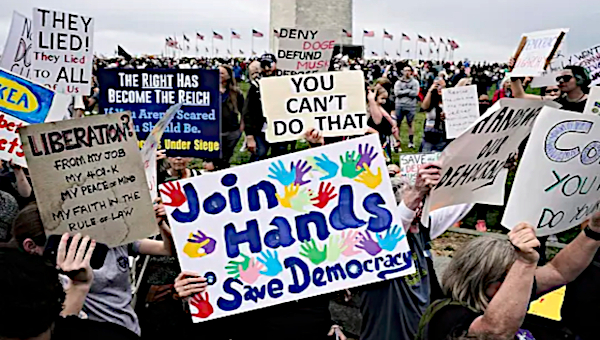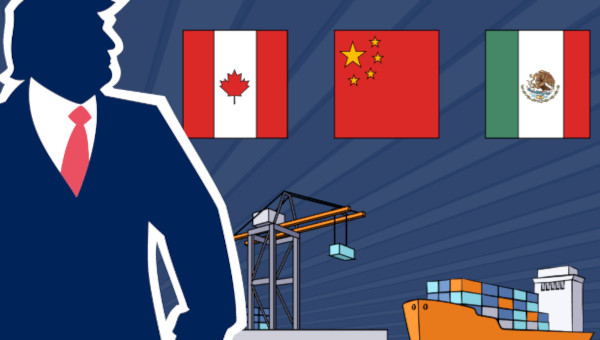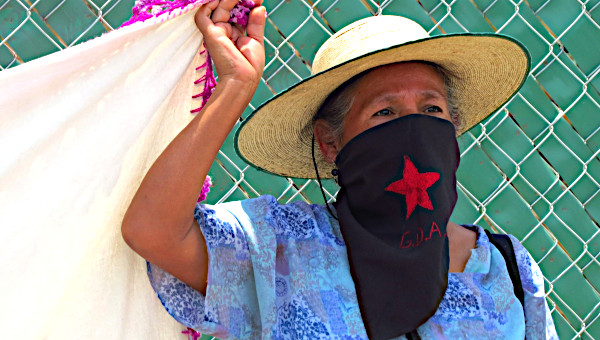Political Conflict and the Mexican Presidential Election
Mexican Presidential elections are always spectacles of the cultural symbols and clichés of Mexico – mariachi bands, twirling parasols, huge flags, marches, the invocation of the cultural heroes of the Mexican revolution and charged speeches. They are also often periods marked by political violence. The Presidential election is set for July 2nd and is rapidly closing in. It has been witness to major conflicts, in San Salvador Atenco and Oaxaca reported on below, between social movement and union activists and the Mexican state. The election race is tight. It is being contested between Felipe Calderon, of the right-wing National Action Party (PAN), Roberto Madrazo of the former longstanding state party Institutional Revolutionary Party (PRI), and Manuel Lopez Obrador of the social democratic Party of the Democratic Revolution (PRD). Obrador is leading in the polls, as he has for much of the campaign. The PAN is struggling to maintain power, access to the ‘spoils’ of the Mexican political system, and their project of deeper North American integration, which President Vincent Fox signed off on in the Waco Accord of a year ago. The Mexican political system is straining just from the possibility of the PRD gaining the Presidency and implementing a mild reform agenda. It would take much more for Mexico to break from the grip of the neoliberal policies it has pursued after the first peso crisis of the early 1980s.
Much of the left is supporting Obrador, partly in opposition to the other parties, and partly in the hope that some openings might result. While some of this is a positive vote, for others it is the familiar ‘vote without illusions’ for the party of lesser evil common across North America. There is also much support, and some great successes, from the Zapatista’s (EZLN) ‘Other Campaign’. The Other Campaign has kept explicit distance from the Presidential contest, and critically commented on the election offers; it has focuses on raising awareness across Mexico of the limits of NAFTA, neoliberalism and capitalism through widely attended community meetings. This follows on the position announced in the 6th Declaration of the Lacandon Jungle by the EZLN in June 2005 to use and an ‘anti-electoral campaign’ as a space to build new social forces.
In light of the Mexican election and the repression of social movement activists coinciding with Mexico taking the Chair of the newly formed United Nations Human Rights Council, The Bullet reproduces here reports on the continued protests against the events in Mexico and the recent developments in Oaxaca.
Mexico and Human Rights: Atenco Protests Continue
Toronto Atenco Solidarity Committee
On June 19, 2006, Mexico began serving its term as the first Chair of the new United Nations Human Rights Council in Geneva. Human rights issues remain, however, a considerable problem internal to Mexico, particularly for trade union activists, women, and indigenous peoples. The International Labour Organization, Amnesty International and other bodies monitoring human rights continually cite Mexico in violation of key international union obligations and protection of core civil and judicial liberties. These issues have been part a matter of international attention since early May, and the violent assault of police on the citizens, particularly social activists and women, of San Salvador Atenco, located in the state of Mexico, just outside Mexico City. Upon it taking over the chair of the Human Rights Council, Mexico should have to answer for the list of human rights violations that have taken place, of which the tragedy of Atenco is but one.
Some background on the Atenco events is in order. On May 3rd and 4th, there were violent police repressions in two adjacent communities just outside Mexico City. It started in Texcoco, where flower merchants were setting up in a local square, slated for development which many in the local community oppose. Police violently and forcibly removed the flower vendors, and also surrounded a building where leaders from the People’s Front in Defence of the Land from the neighbouring community of Atenco was meeting. Atenco is known for its longstanding resistance to the government over corporate development on its lands. In 2002, they forced the government to back away from an international airport development on their lands, and they continue to resist this proposal.
When the police began their attacks on the flower merchants in Texcoco, and isolated Atenco resistance movement leaders, an appeal was sent up the highway so to speak, asking the residents of Atenco to block the highway in order to prevent the expected onslaught of more police. The people of Atenco united and blocked the highway. Five hundred state police confronted 300 or so Atenco residents and their supporters, among them university students, who managed to drive away the initial police raid. Several police were severely beaten; fourteen were taken hostage and later released to the Red Cross. But by the following day state and federal police, now numbering 2000, had occupied Atenco; then the real terror began. The police went from house to house and rounded up people, including those uninvolved locals who simply took people into their houses to protect them from the violence.
People were severely beaten, intimidated and tortured. Thirty of 47 women arrested have reported sexual assault by police, who they report came with condoms in their pockets and a clear intent to rape. Journalists, both foreign and national, were targeted for beating and arrest, and their recording devices were confiscated. The leadership of the Atenco resistance movement has been arrested, their family terrorised, and houses destroyed. Three police officers who participated in the raids confirmed that a fourteen year-old boy was killed by a gunshot wound fired by police. A university student activist in a hospital in a coma with severe head injuries from an exploded tear gas canister lobbed by police later died. Five foreign nationals, including a Chilean documentary maker and student at a Mexico City film school, and a German documentary maker, were deported following their brutal arrests and have been banned from re-entry to Mexico for five years. Around 200 people were arrested, and many remain in custody, and others have disappeared.
These events led to a series of protests in several cities in Mexico and North America over human rights violations in Mexico, the recent attacks on striking teachers in Oaxaca, the May police violence in Atenco and the continued detention of Atenco citizens.
Protests were also organized in Toronto on Monday. A letter denouncing the repression of May 3rd and 4th in Atenco, signed by about four hundred individuals and nine organizations, was delivered to the Mexican Consul, Mr. Miguel Angel Caceres, and was then to be forwarded on to government officials in Mexico City. The letter was presented by the Toronto-Atenco Solidarity Committee, and calls on the Mexican government to prosecute the parties that planned and perpetrated the physical and sexual assaults and torture against detainees; release of all prisoners detained; that the Government of Mexico, as called for by the United Nations Office of the High Commissioner for Human Rights in Mexico, submit to an independent public investigation into human rights abuses committed during the Atenco attacks; and the right of safe return to Mexico of foreign nationals who have legal migratory status in Mexico.
After the delegation, a rally was held outside the consulate, located on Bay Street, in the heart of Canada’s financial district. People came with banners and signs, handed out leaflets, read testimonials from the women victims, and chanted ‘NO MORE ATENCO, NO MORE REPRESSION’. Political art was also mounted, with posters, a clothesline with bloody women’s clothing hung to represent the sexual torture used against the women of Atenco, and the outline of dead bodies chalked out on the sidewalk. The activists also described recent developments in Oaxaca, where the Mexican government has brutally put down a group of teachers on strike and demanding improved working conditions.
This event was preceded by protests against Mr. Enrique Pena Nieto, the Governor of Mexico State, at an appearance in Toronto on Friday June 16, to speak about economic development. The Governor was participating in the Metropolis Conference which was made up of many international delegates and held at the Intercontinental Hotel. He was one of a panel of six speakers at a commission on private-public partnerships.
Governor Pena Nieto happens to be one of the people responsible for the police violence that was unleashed on the residents of Atenco and Texcoco. The Toronto-Atenco Solidarity Committee set up a picket in front of the hotel. Placards implicating Governor Pena Nieto in the brutal repression of May were carried by demonstrators. Leaflets were distributed to passers-by and conference participants. They were also asked to sign a letter of protest to Mexican authorities in Mexico City and in Toronto about the Atenco abuses. The lack of mainstream media coverage in Canada – although the alternative media has reported the story extensively – meant that most people were oblivious to the recent events in Mexico State.
Members of the Atenco Solidarity Committee also ventured into the Metropolis Conference. During the question period, they confronted Governor Pena Nieto with the Atenco abuses and the continued human rights violations of prison detainees. He refused to respond to the allegations made against him and the State of Mexico. Because of the questions and protests about Atenco from the floor, the Commission was forced to adjourn. There was also noticeable support shown to the protesters from the audience after the moderator was forced to close the meeting. The questioners from the Solidarity Committee were then ejected from the building by security. Many participants to the conference, particularly from the European and Latin American delegations, came out to congratulate the people who had planned the protest for having denounced the governor. Some recognised that they were not that surprised by the accusation, saying “we knew the previous governor, Montiel from the PRI, but this one, which seems to have inherited the position from him, this one is even worse.”
Governor Pena Nieto was made aware as well of the protests outside the conference against the violence in Atenco. He could not avoid the embarrassment of his human rights records coming before delegates at the conference.
The Mexican authorities need to recognize that Canadians are deeply offended by the terror unleashed by the Mexican state in May against the community of Atenco. Canadians stand in solidarity with the peoples and social movements of Mexico, and defend the right of Mexicans to organize for social justice now in Atenco and into the future across Mexico.
It is important to closely watch the unfolding situation in Mexico. A climate of repression has formed a backdrop for the rapidly approaching July 2nd Presidential election, hotly contested between Felipe Calderon, of the right-wing PAN party, Roberto Madrazo of the former longstanding state party PRI, and Manuel Lopez Obrador of the social democratic PRD. The Mexican political system is straining partly from just the possibility of the mild reformism posed by Obrador and the PRD gaining the Presidency, and the successes of the Zapatista ‘Other Campaign’ raising awareness across Mexico of the limits of NAFTA, neoliberalism and capitalism.
Atenco Update: Vigils Continue
Mexico Solidarity Network
Italia Mendez became the first woman raped by police in San Salvador Atenco on May 4 to come forward publicly with her accusations. Italia, who is currently free on bond but charged with public disturbance, gave testimony to the Special Investigator for Violence Against Women. Italia, who works for an NGO dedicated to children in vulnerable situations, arrived in Atenco on May 3 to assist families whose children were detained by police. Although she carried letters from her organization describing her activities, police arrested her: “They threw me on the back seat of the bus on top of two people and they beat me, tore off my clothes and I was raped by three people. They said they would rape my mother and my sisters, because they had my address. The first officer spoke to another officer and said, ‘come here and try out this whore that I have.’ They turned me over continually, on my back then on my stomach. Afterward, a third officer violated me with an object. I was scared; I didn’t want to say anything because if I did they would beat me more.”
In the week of June 12, nine police officers were sanctioned for ‘excesses’ committed on May 4. Four officers were fired and five were suspended for 90 days. To date, these are the only official sanctions against more than 2,000 officers who participated in the May 4 actions, and none of the commanders have been sanctioned, despite evidence that police came to Atenco with condoms apparently intending to rape arrestees. Amnesty International criticized the Mexico State Attorney General for a cover up and called for federal authorities to take charge of the investigation, but Governor Enrique Pena refused, claiming the State of Mexico was perfectly capable of carrying out a full and impartial investigation. In a press conference in New York on Thursday, Pena said, “It is well known that in the manuals used by insurgent groups, by radical groups, the first thing the manual says is to declare that women have been raped, and in the case of men, to have been the object of abuse and bad treatment, because this is the way these groups do things.”
A 24-hour vigil continues in front of the two prisons where 31 Atenco residents and supporters are held, charged with kidnapping. The Other Campaign is demanding the release of all Atenco prisoners and justice for the hundreds who were raped and beaten.
The Mexico Solidarity Network is at www.mexicosolidarity.org
Oaxaca: Mega March Replies to Police Violence
International Viewpoint
Hundreds of thousands marched into Oaxaca, Friday 16 June, to support striking teachers whose encampment was brutally attacked by police on Wednesday. The march went to the Zocalo (central square), already retaken by the demonstrators on Thursday.
Led by section 22 of the SNTE teachers union, the march was supported by students from the university of Oaxaca, local health and university workers and numerous other union, popular and left wing organisations -including a contingent from the Frente en Defensa de la Tierra in San Salvador Atenco and other supporters of the EZLN’s ‘Other Campaign’.
The principal demand of the demonstrators was the resignation of state Governor Ulises Ruiz Ortíz of the right-wing Institutional Revolutionary Party (PRI), widely accused of corruption.
Organisers put the numbers marching at 300,000, the police said 70,000 and the governor’s office said 15,000. Last Wednesday’s attack on the Oaxaca is the latest in a series of brutal actions by paramilitary police against striking copper miners, residents of Atenco and communities in Isla Mujeres that are trying to prevent their island becoming a rubbish dump for the trash from Cancun. Two were killed in Atenco and two copper miners also died.
These actions, directly organised by the national intelligence committee chaired by President Vicente Fox, are widely seen as trying to create a ‘strategy of tension’ – a climate of fear aimed at discrediting the EZLN’s ‘Other campaign’ and ensuring a right-wing victory in the July 2 presidential election. Recent opinion polls put Felipe Calderon, candidate of Fox’s right-wing National Action Party (PAN) slightly behind Andres Manuel Lopez Obrador, candidate of the centre-left PRD.
After negotiations the state government released 10 teachers arrested on Wednesday and suspended the arrest orders on 25 leading union activists. Negotiations on the teachers pay and other demands are continuing.
Earlier reports of deaths among the teachers on Wednesday have not been confirmed. But according an eyewitness report posted on Narco News, June 17, “One of the unconfirmed dead was a child from the town of Villa Alta. Names of the dead and injured were not released for family security reasons, and true numbers remain a secret. Gossip is everywhere, including the assertion that URO has the bodies under lock and key in a morgue. Although the names of the wounded, including police, have been made public, the names of the alleged dead and their numbers have not.
“According to the leader of Section 22, Enrique Rueda Pacheco, 20 teachers were arrested, and eight ‘disappeared’. According to Noticias on June 15, Pacheco said that two teachers and two children were killed. Between 30 and 100 were wounded from both teacher and police sides of the fight, according to various unofficial sources.”
International Viewpoint is available at: www.internationalviewpoint.org





